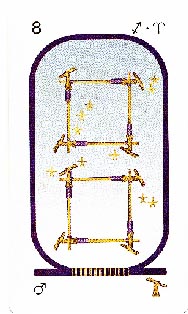
This deck is a re-drawn and colorized version of the black-and-white Brotherhood of Light Egyptian Tarot created by Gloria Beresford in 1936. This 78-card deck is an original and uniquely American variant based on C. C. Zain’s book, “The Sacred Tarot.” As such, it is worth examination and study, both for its historic contributions as well as for its esoteric value.
Zain’s work was initially inspired by an ancient book by the late-classical Neo-Platonist writer Iamblicus (“Egyptian Mysteries”) that was translated in the late 18th century. Zain started writing in 1912, and offered an extensive correspondence course in occult studies that continues to this day through his Brotherhood of Light organization. The contents of the LWB included with the deck are excerpted from his book, “The Sacred Tarot.” Zain’s unique Silver Key attribution system appears to be derived from the work of French mystics like Paul Christian and St. Germaine (aka Edmond Valcourt-Valery), and so is divergent from the British or other European systems that may be more familiar to modern tarotists. Where the LWB is limited to brief excerpts, appropriate BOL booklets are recommended for further edification. Two sample spreads are included at the end of the booklet (and neither is the Celtic Cross).
A cartouche on each card contains the tarot imagery, while the card number and various attributions are displayed at the borders. Minor Arcana cartouches are color-coded by suit. The Trump card images are, for the most part, Egyptianized variations on pre-RWS tarot decks. Many of the cards have a constellation of stars near the top of the cartouche. Overall the visual impression of the cards is clean and uncluttered, with a controlled color palette and thoughtfully restricted imagery.
Trump cards display corresponding Hebrew, Roman and Sanskrit letters at the bottom of each card, and have the card number (both Roman and Arabic forms) and the astrological attribution at the top. In this system, the Magician = Aleph. Some of the titles of the Trump cards vary: the High Priestess is Veiled Isis; the Empress is Isis Unveiled; the Emperor is The Sovereign; the Lovers is The Two Paths, etc. The Materialist (Fool, #22) card is moved to the end of the sequence of trumps.
The Court Cards also have some idiosyncrasies. Here upright Kings are men, reversed Kings are women; upright Queens are women, reversed, men. The Kings, Queens and Pages are each assigned to a whole zodiac sign, and zodiacal traits are a main point in the brief card meanings. A Page or “Youth” is signified by a “J”. Knights are Horsemen (“H”), and represent thoughts, ideas and unseen intelligences. When upright, these are favorable to the client; when reversed, unfavorable or problematic.
The pip cards (numbered Ace through Ten) correspond by number group to the first ten cards of the Major Arcana, i.e., the Aces correspond to the Magician. The elemental identities of the suits diverge from the mainstream assignments as well: Scepters (Wands, fire); Swords (earth); Coins (Air), and Cups (water). The Ace through Nine pip cards are each assigned to one of the 36 decans of the zodiac. The decanates came into common use when 18th century French astrologers broke away from Ptolemaic dignity system by abandoning the Faces and by adding newly discovered planets as sign rulers.
While Zain’s system relies heavily on astrological attributions and the assignments are given on the border of the cards, each Trump (or Arcanum) card is explained in terms of the spiritual, intellectual and physical worlds, with little emphasis on the zodiacal attribution. Either the original text of “The Sacred Tarot” contains much more information, or it is assumed that the student will obtain the recommended booklet from the organization to extend understanding of these attributions. An overview of the numerological import and the influence of the dominant Trump card precede the brief divinatory meanings of the cards of each suit.
The Brotherhood of Light Egyptian Tarot, both cards and LWB, were initially disorienting, but the deck reeled me in as I worked with it. The unfamiliar attribution system and elemental assignments required some mental gear-shifting! This deck offers a welcome opportunity to learn about Zain’s unique system and methods for using it. The Egyptianized tarot imagery may be quite attractive to some readers, and may also appeal to individuals who enjoy using decks with un-illustrated pip cards. I highly recommend this deck for those who wish to learn more about Zain’s Silver Key attribution system and the historic place the Brotherhood of Light tradition holds in the field. This is a worthy, well-designed update of a classic tarot deck.
~review by Elizabeth Hazel
Tarot deck by Vicki Brewer
The Church of Light/US Games Systems, Inc, 2009
Boxed 78-card deck and booklet, $18.00.
(review previously published in ATA Quarterly Journal, Summer 2010 issue)




